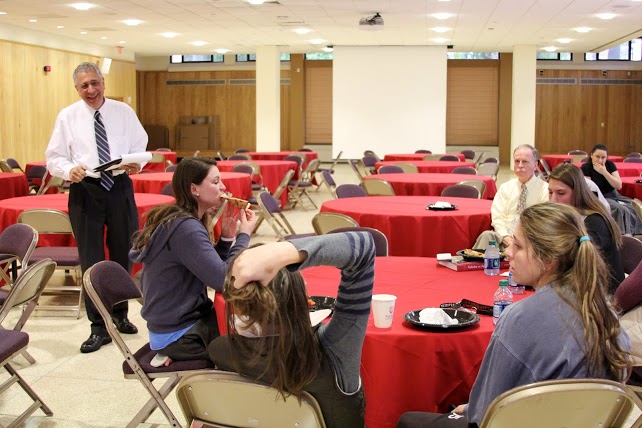Photo by Atdhe Trepca/The Mirror
Fewer than 15 students came in and out of the two-hour-long Food Service Open Forum on Oct. 16. Stacks of uneaten pizza sat on the table next to full bowls of salad, all barely picked at by the few student attendees. The large Oak Room dwarfed the perception of the turnout, since less than a quarter of the Oak Room was filled with students.
This initiative to make decisions based on student opinion is very crucial to students’ future dining experiences, according to Assistant Vice President of Student Services Jim Fitzpatrick.
Before the forum started, Fitzpatrick commented that his “gut feeling is that [attendance] probably won’t be that high, due to the busy nature of student schedules.”
He said there has been little progress on the issue of dining services since the last time that The Mirror spoke with him because “we’re just in the infancy stages of the program.
“I think the word is getting out there among the other food services that the contract will be out to bid so I’m pretty sure they’re all aware of it by now … but word spreads pretty quickly on the street and I’m sure most of the major companies, if not all of them, that may have an interest in Fairfield, will be out to bid,” he said.
Fairfield’s food consultant and representative from the Rochelle Group, Ted Mayer, was hired to work with the administration and the Request For Proposal process. Mayer made it clear that he had no affiliation with any other food service group, such as Sodexo.
In describing the RFP process and what Mayer will be doing with the information collected from the students, he broke it down into three phases.
In the first phase, Mayer and his group will be “reading lots of reports, financials, student comments, surveys [and] looking at menus.”
In the second phase, the Rochelle group will be “looking at the kitchens: How do they run? Are they organized? Whether they’re clean, how do they produce food?”
Finally, in the third phase, Mayer and his group will talk to students, “the stakeholders.” Mayer described this process in the discussion: “You can tell me what you would like and I will take copious notes. I will synthesize all the data. The data I get from you and all the reports. And then we start the RFP process.”
“All we’re doing is listening. We’re listening to you. There’s no presentation on our end,” Fitzpatrick said to the students.
Students voiced their opinion on how much they enjoyed the stir fry options or the “hot chocolate machine,” according to Felicia Sapoli ‘16.
The biggest concern for students now is whether these forums or discussions will have any implication for dining services at Fairfield. Sapoli said she is worried that “our voices won’t be heard.”
Freshman Julie Czapkowski said, “I looked at the beautiful campus and thought that the food would be better.”
As the large Oak Room sat only 25 percent occupied, the significance of student involvement became apparent. According to Fitzpatrick, student involvement is “just crucial” since “the perceptions of 65-year-old administrator versus a 21-year-old junior are probably coming in two different ways.”
Despite the discouraging turnout of participants, Fitzpatrick remained hopeful: “The students that did come were very . . . vocal, honest and open. And that’s what we were hoping for.”


Leave a Reply